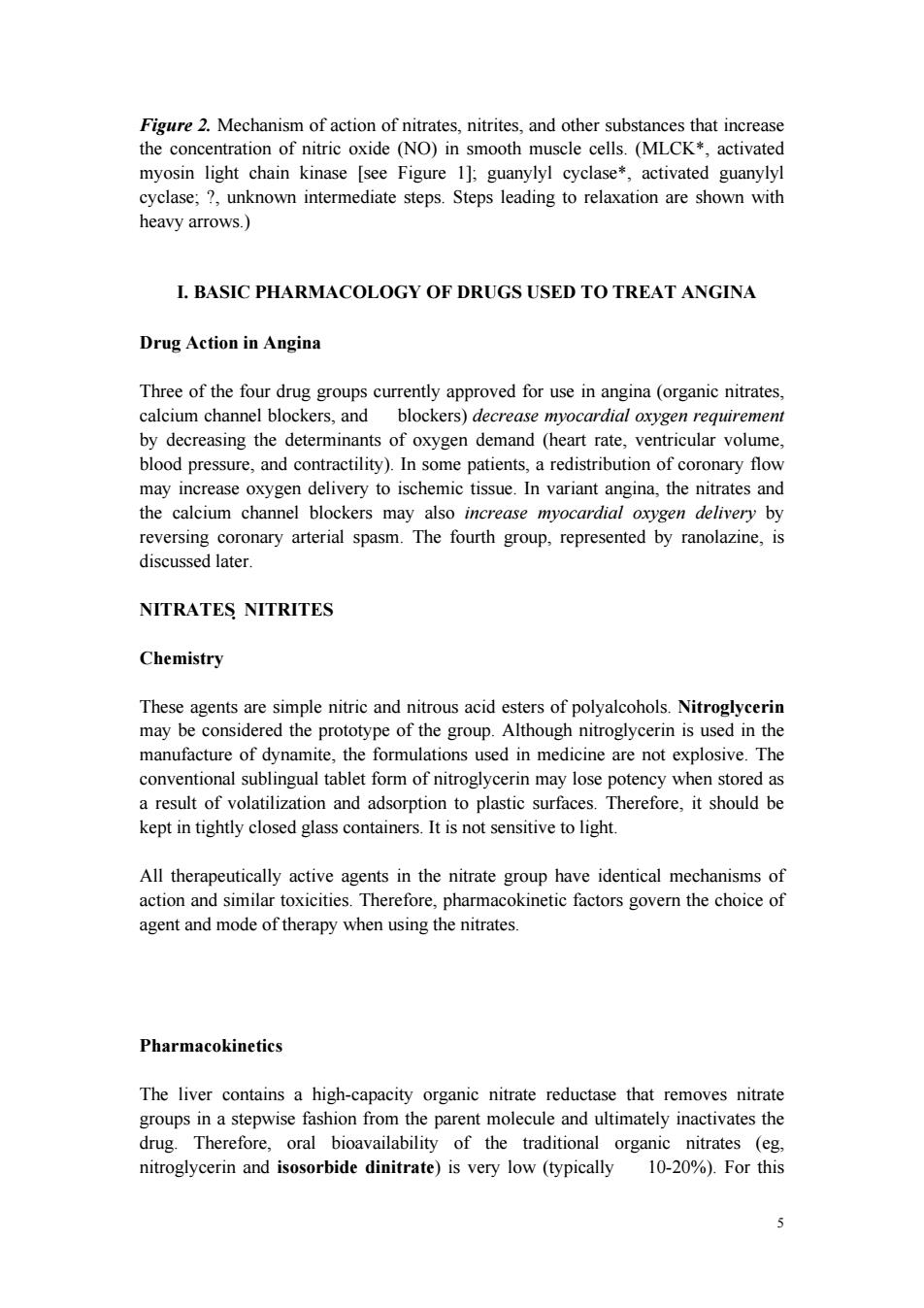正在加载图片...

Figure 2.Mechanism of action of nitrates,nitrites,and other substances that increase the concentration of nitric oxide (NO)in smooth muscle cells.(MLCK*,activated myosin light chain kinase [see Figure 1];guanylyl cyclase*,activated guanylyl cyclase;?unknown intermediate steps.Steps leading to relaxation are shown with heavy arrows. I.BASIC PHARMACOLOGY OF DRUGS USED TO TREAT ANGINA Drug Action in Angina Three of the four drug groups currently approved for use in angina(organic nitrates, calcium channel blockers,and blockers)decrease myocardial oxygen requirement by decreasing the determinants of oxygen demand (heart rate,ventricular volume, blood pressure,and contractility).In some patients,a redistribution of coronary flow may increase oxygen delivery to ischemic tissue.In variant angina,the nitrates and the calcium channel blockers may also increase myocardial oxygen delivery by reversing coronary arterial spasm.The fourth group,represented by ranolazine,is discussed later. NITRATES NITRITES Chemistry These agents are simple nitric and nitrous acid esters of polyalcohols.Nitroglycerin may be considered the prototype of the group.Although nitroglycerin is used in the manufacture of dynamite,the formulations used in medicine are not explosive.The conventional sublingual tablet form of nitroglycerin may lose potency when stored as a result of volatilization and adsorption to plastic surfaces.Therefore,it should be kept in tightly closed glass containers.It is not sensitive to light. All therapeutically active agents in the nitrate group have identical mechanisms of action and similar toxicities.Therefore,pharmacokinetic factors govern the choice of agent and mode of therapy when using the nitrates. Pharmacokinetics The liver contains a high-capacity organic nitrate reductase that removes nitrate groups in a stepwise fashion from the parent molecule and ultimately inactivates the drug.Therefore,oral bioavailability of the traditional organic nitrates (eg, nitroglycerin and isosorbide dinitrate)is very low (typically 10-20%).For this 55 Figure 2. Mechanism of action of nitrates, nitrites, and other substances that increase the concentration of nitric oxide (NO) in smooth muscle cells. (MLCK*, activated myosin light chain kinase [see Figure 1]; guanylyl cyclase*, activated guanylyl cyclase; ?, unknown intermediate steps. Steps leading to relaxation are shown with heavy arrows.) I. BASIC PHARMACOLOGY OF DRUGS USED TO TREAT ANGINA Drug Action in Angina Three of the four drug groups currently approved for use in angina (organic nitrates, calcium channel blockers, and blockers) decrease myocardial oxygen requirement by decreasing the determinants of oxygen demand (heart rate, ventricular volume, blood pressure, and contractility). In some patients, a redistribution of coronary flow may increase oxygen delivery to ischemic tissue. In variant angina, the nitrates and the calcium channel blockers may also increase myocardial oxygen delivery by reversing coronary arterial spasm. The fourth group, represented by ranolazine, is discussed later. NITRATES NITRITES Chemistry These agents are simple nitric and nitrous acid esters of polyalcohols. Nitroglycerin may be considered the prototype of the group. Although nitroglycerin is used in the manufacture of dynamite, the formulations used in medicine are not explosive. The conventional sublingual tablet form of nitroglycerin may lose potency when stored as a result of volatilization and adsorption to plastic surfaces. Therefore, it should be kept in tightly closed glass containers. It is not sensitive to light. All therapeutically active agents in the nitrate group have identical mechanisms of action and similar toxicities. Therefore, pharmacokinetic factors govern the choice of agent and mode of therapy when using the nitrates. Pharmacokinetics The liver contains a high-capacity organic nitrate reductase that removes nitrate groups in a stepwise fashion from the parent molecule and ultimately inactivates the drug. Therefore, oral bioavailability of the traditional organic nitrates (eg, nitroglycerin and isosorbide dinitrate) is very low (typically 10-20%). For this